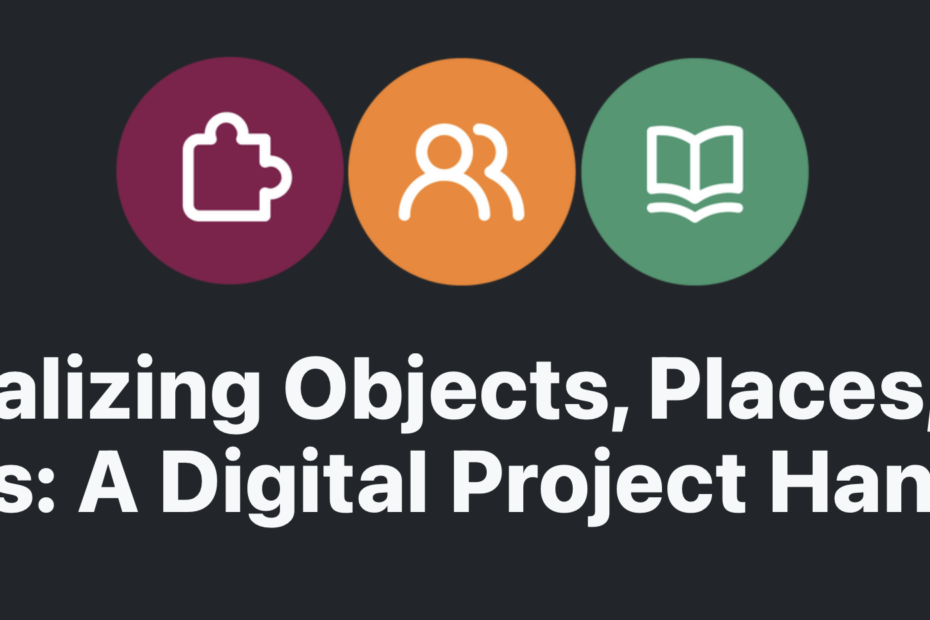Update from Visualizing Objects, Places, and Spaces: A Digital Project Handbook
March 1, 2023
About
A digital project handbook for researchers and instructors in the early stages of digital project development. This web publication offers:
- guidance on workflows, resources, and computational principles;
- topics applicable to many types of projects, including those that arise in archival, dimensional, narrative, quantitative, spatial, temporal, and network visualization projects;
- modular, downloadable content, allowing users to build custom annotated guides.
Call for Reviewers
Seeking Peer Reviewers: Networked & Quantitative Project Types
We’re drafting the Networked and Quantitative sections of the Handbook, and we’re seeking volunteer reviewers who can read our sections and provide feedback.
Interested in learning more about network and quantitative methods of visualization?
Are you an expert in either of these methods? Email us at digitalhandbook@duke.edu if you’d like to be a reviewer. We’re seeking reviews from those new to quantitative visualization as well as pros, and everyone in between.Reviewers can be staff, students, faculty, independent scholars, practitioners working in industry, etc. While this work is entirely volunteer, reviewers can be credited (see this example).
Know of someone who might be interested in reviewing? Please share this news with them.
New Case Studies in the Handbook

ArchivalGossip.com: A Scholarly Take on Nineteenth-Century Tattle Tales
What does gossip “know”? How does it “know” it? This case study describes ArchivalGossip.com, a digital platform that presents a collection of letters, diaries, cartoons, photographs, paintings, auto/biographies, and newspaper articles on the subject of gossip. Through exhibits, timelines, maps, and more, the authors explore the concept of gossip as a value commodity for American women in the nineteenth century.
ArchivalGossip.com: A Scholarly Take on Nineteenth-Century Tattle Tales is a classic example of a project combining the affordances of Omeka and WordPress to create a platform that acts as both research and pedagogical tools. Authors Selina Foltinek and Katrin Horn describe not only the methods used but also the many resources that they used to create this digital archive and reflect on the many tools they used, including Transkribus, mapdevelopers.com, Palladio, and D3 to produce the project. Their detailed case study also provides insight into the key roles that relationship-building and funding have played in the project’s development.

Developing an agent-based model for studying shipwreck site formation processes.
Agent-based modeling (ABM) is a technical method used by many disciplines to simulate the many ways an event may have taken place. For archaeologist Rodrigo Vega-Sánchez, ABM has proven key to understanding a mystery surrounding a nineteenth-century brig-of-war shipwreck off the coast of Veracruz, Mexico. In this case study, Vega-Sánchez used 3D modeling and the game engine Unreal to imagine the many environmental factors that may have impacted the ship’s initial sinking and its subsequent deterioration/preservation on the seabed.
The first case study in the Handbook to demonstrate ABM, Developing an agent-based model for studying shipwreck site formation processes offers helpful insight into the various stages required to develop an ABM, from historical research, to building a conceptual model, to creating an interactive simulation platform in Unreal Engine 4 that ultimately enabled Vega-Sánchez to test a range of hypotheses.
Submit a Case Study or Assignment
Have a project or assignment that you’d like to see included in the Handbook? Consider submitting a case study or assignment:
Case studies are short overviews of digital research projects that help Handbook readers see what digital research projects actually look like in practice.
Assignments are ideas for how projects and lessons on digital topics can be implemented in a classroom, including details like how much time or expertise are required, and whether they work best for a certain size of class.
We review submissions on a rolling basis. Details on how to submit are available here.
Keep in Touch
Do you know folks who would be interested in our project? Please share this news and encourage them to subscribe our newsletter. If you have comments or questions for us, we’d love to hear from you at digitalhandbook@duke.edu.
